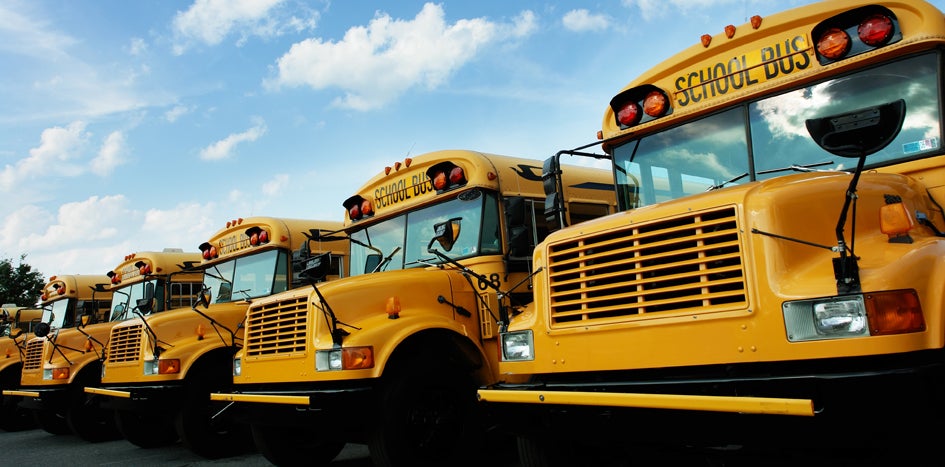Protect School Property from Spring Storms
Weather can be unruly, especially during spring storm season. High winds, hail, tornados, and flooding can damage school property and leave behind unbudgeted repair or replacement costs. You might even have to relocate students until facilities are up and running.
Follow these tips to protect your schools during spring storm season.
Common Risks
- Roofs, vehicles, outdoor equipment, and exterior doors and windows damaged by hail or fallen trees
- Flooded facilities
- Power and business interruptions
- Infestation of animals seeking shelter
- Power surges and fires caused by lightning strikes
Preventative Measures
You should develop preventative measures for the specific hazards in your region, but here are general action items to consider:
Shore Up Your Emergency Operations Plan (EOP)
Your EOP should include severe-weather annex that documents your preparation and response strategies. Develop protective measures for every campus and auxiliary building, including administration, maintenance, and transportation.
Maintain Roofs
- Inspect roofs at least twice a year and practice preventative maintenance.
- Establish rooftop control procedures, log roof access, and advise contractors to use caution with heavy tools and equipment.
- Clear gutters, roof drains, and downspouts of debris. Otherwise, water could overflow and enter facilities.
- Maintain all records of roof maintenance and inspection reports. Be ready to submit documentation to claims adjusters if a storm claim is filed for roof damage.
Related resource: Fund members with Property coverage can customize this roof preventative maintenance plan to meet their needs.
Pro tip: Choose hail-resistant roof material. Research by FM Global, a a leading third-party, global testing laboratory and certification agency of property loss prevention products and services, shows that most of Texas falls in a “severe hail” zone. Consult the agency’s roof system certifications, which include “Very Severe Hail” ratings, before investing in new roofs.
Practice Good Housekeeping
- Trim or remove dead or dangling tree branches that could break and damage building exteriors.
- Make sure windows are properly sealed and ready to keep water out.
- Remove outdoor debris that could become airborne during heavy winds.
- Put outdoor athletic equipment inside to prevent it from being blown away or damaged.
- Similarly, make sure doors are sealed at the base to prevent water from flowing inside.
Move Vehicles Under Cover
TASB property adjusters aren’t the only staff who stay busy during spring storm season. Our auto adjusters also handle their share of claims from hail-damaged vehicles. Identify locations to move vehicles under cover before storms are predicted, and train staff to act in time when severe weather is forecasted.
Related: Learn how hail guards reduce the risk of costly damage to HVAC systems.
Monitor the Weather
Sign up for weather alerts and follow credible sources such as the National Oceanic and Atmospheric Administration and the National Weather Service to ensure storms don’t catch you by surprise.
Respond to Hail Notifications
The Fund receives hail notifications that pinpoint when and where hail falls. TASB claims staff notifies impacted members and provides guidance on how to proceed. Responding to hail notifications is an important responsibility of Fund membership, and late responses could impact coverage. A quick response also helps you identify potential damage and control its impact.
Property Damage Playbook
If your property has been hit by a storm, follow these tips to maintain a safe environment and prepare for the claim process:
- Secure the area and protect property against further damage.
- Cover building contents and other exposed property.
- Tell your adjuster immediately if you believe a building may be structurally unsafe.
- Board up broken windows, holes in walls, leaking roofs, and other damaged property.
- If emergency repairs are necessary, take photographs and keep a record of costs. Photos and receipts will be required for reimbursement.
- File a claim immediately (or as soon as possible). Keep reading for more information.
Your Guide to the Fund Claims Process
If your organization is a Fund member with Property coverage, here’s how we work with you to get students back in classrooms and your operations back to normal quickly and cost effectively.
- You should report a claim immediately or as soon as possible online or by phone at 800-482-7276. If you don’t report within the timeframe noted in your Fund Property coverage agreement, the claim might not be covered. You will find your Property coverage agreement on your risk dashboard.
- A TASB adjuster will call you to discuss the details and explain the claims process.
- An independent adjuster and/or building consultant will usually conduct the initial inspection to assess damage. The timeframe depends on the severity of the damage. A complete assessment of your claim may require inspections and consultations from multiple professionals, such as:
- TASB claims managers and/or representatives
- Independent adjusters
- Building consultants
- Structural engineers
- General contractors
- Roofing specialists
- Cleanup and restoration companies
- Following the investigation and inspections, you will receive a written repair estimate. This is just an initial estimate and overview of covered damage/repairs. Your TASB adjuster will call you to explain the details and answer your questions. Remember, your adjuster is available to help you throughout the claims process.
What’s Covered?
Once we have all reports, estimates, and documentation about the damages claimed, we will review for coverage. Our review includes what was damaged, how it was damaged, and to what extent. Your TASB adjuster will discuss the coverage determination with you when it is fully reviewed.
If you file a claim, see your Property coverage agreement for the definitions of these key terms: building, other structures, and personal property.
Get Familiar with Your Coverage
Your coverage has limitations and exclusions. Refer to the Property Coverage Agreement for more information. For details about your specific coverage, refer to your Contribution and Coverage Summary or contact your TASB adjuster.
Editor's note: This article was originally published in May 2017 and has been updated for accuracy and comprehensiveness.
Risk Solutions Staff
The TASB risk solutions team includes risk solutions consultants and communications professionals who deliver training, consultations, articles, and resources that help Fund members control losses and their associated costs.
You May Also Like…
View All Related Insights
The Basics of School Fleet Management
Your community relies on your district's vehicles, so take care of your buses, trucks, and cars with these fleet management basics.

Want to Worry Less About Data Breaches?
The accidental release of sensitive information can tarnish your organization’s reputation. Data loss prevention tools help ensure that when employees make mistakes, technology has your back.

Protect Your Fleet With a Preventative Maintenance Plan
If you want to protect your vehicles and their passengers, you need an effective preventative maintenance plan.

5 Benefits of Career and Technology Education Liability Coverage
Career and Technology Education Liability Coverage applies to students working in local or chain businesses as part of a CTE program. Here are five things to know.
